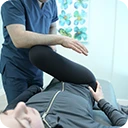Benefits of Spinal Decompression Therapy
What exactly is spinal decompression therapy?
Some level of back pain is quite common in most adults, and many people who have severe issues with this body part turn to motorized traction – spinal decompression therapy being a common type. This therapy works by gently stretching the spine to both change the position of the spine and the force of it. By doing this, it lowers the demands required by the spinal disks by creating negative pressure within the disks. The successful result in doing this retracts herniated or bulging disks, and in-turn alleviates pressure on the spine’s nerves and other supporting structures. After this occurs, the healing process begins when the disks get back oxygen, nutrient-rich fluids, and water, as these three elements start their natural internal movement once again.

There are a few conditions where spinal decompression therapy is effective including:
- Diseased or injured spinal nerve roots
- Herniated or bulging disks
- Degenerative disk disease
- Neck or back pain
- Sciatica – this being tingling, weakness, or pain that is experienced down the leg
- Posterior facet syndrome, or more commonly known as worn spinal joints
People should be aware that more extensive research is required to properly understand the effectiveness and safety of spinal decompression therapy.
What does the process of spinal decompression look like?
You as the patient remain completely clothed throughout each therapy session, and the doctor starts out by properly fitting you with a harness that goes around your trunk and pelvis. Depending on the computer-controlled table used and you as a patient – you lie either face up or face down on it.
Depending on your specific needs for this type of therapy, the doctor customizes the treatment by operating the computer in such a way as to maximize its effectiveness.
Therapy typically lasts for 30 to 45 minutes for each session, and over the course of one to two months the therapy schedule may include 20 to 30 sessions. Other types of treatment and evaluation either before or after the therapy sessions can include cold or heat therapy, ultrasound, or electrical stimulation.
Surgical spinal decompression
Up until this point, we have outlined the nonsurgical form of spinal decompression, but there’s also surgical options as well including diskectomy, laminectomy or laminotomy, foraminectomy or foraminotomy, osteophyte removal, and corpectomy. The surgical side of spinal decompression is often used as only a last resort if other treatments and therapies don’t work when dealing with issues such as ruptured or bulging disks, bony growths, or other spinal problems. The goal is to remove pressure on the spinal cord or nerves to relieve symptoms ranging from weakness, numbness, tingling, or pain.
Let us help you
Limelight Wellness is proud to help all types of patients with their back, neck, spine, and other pain that can be dealt with through the use of spinal decompression therapy.
Contact us today so we can learn more about your condition(s), and we can outline how we can successfully execute an effective treatment plan.
Share it to somebody how needs to know it































